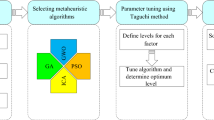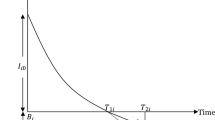Abstract
This study presents a multi-item inventory and pricing model by considering marketing, service activities, trade credit, carbon emissions, and the restrictions of production cost and storage space. In the proposed model, shortages are allowed and demand rate is a power function of service and marketing costs, and selling price. The main objective of this study is to optimize retailer’s payments time, service and marketing expenditure, and replenishment decisions in order to maximize retailer’s total profit and minimize carbon emissions, simultaneously. Model is developed in a fuzzy environment under carbon tax regulation when the length of credit period provided by supplier is less than or equal to the length of time in which no shortage happens. To solve the proposed model, we first transform the original problem into a multi-objective Signomial Geometric Programming (SGP) problem using fuzzy and hybrid parameters, which minimizes both the mean value and the total dispersion value of the objective function. Then a global optimization problem method has been used to solve the SGP problem. Efficiency of this algorithm is tested and compared with multi-objective genetic algorithm, multi-objective genetic algorithm with varying population, and hybrid heuristic algorithm. At the end, several numerical examples and sensitivity analysis are performed to demonstrate the application of the proposed model and solution procedure to obtain managerial insights.





Similar content being viewed by others
Notes
DD = The number of decision variables + the numbers of terms in objective functions and constraints − 1.
References
Aliabadi L et al. (2017) An EOQ model with holding-ordering cost reduction and partial delay in payment under credit period-dependent demand: a reversed constraint programming. In: 13th International conference on industrial engineering (IIEC 2017), Mazandaran
Azadeh A et al (2017a) Evolutionary multi-objective optimization of environmental indicators of integrated crude oil supply chain under uncertainty. J Clean Prod 152:295–311
Azadeh A et al (2017b) Optimum integrated design of crude oil supply chain by a unique mixed integer nonlinear programming model. Ind Eng Chem Res 56(19):5734–5746
Bozorgi A et al (2014) A new inventory model for cold items that considers costs and emissions. Int J Prod Econ 155:114–125
Cao E, Yu M (2018) Trade credit financing and coordination for an emission-dependent supply chain. Comput Ind Eng 119:50–62
Chang C-T et al (2009) Optimal payment time with deteriorating items under inflation and permissible delay in payments. Int J Syst Sci 40(10):985–993
Chen S-C et al (2014) Retailer’s economic order quantity when the supplier offers conditionally permissible delay in payments link to order quantity. Int J Prod Econ 155:284–291
Dey O (2017) A fuzzy random integrated inventory model with imperfect production under optimal vendor investment. Oper Res. https://doi.org/10.1007/s12351-016-0286-1
Dye C-Y (2012) A finite horizon deteriorating inventory model with two-phase pricing and time-varying demand and cost under trade credit financing using particle swarm optimization. Swarm Evolut Comput 5:37–53
Dye C-Y, Yang C-T (2015) Sustainable trade credit and replenishment decisions with credit-linked demand under carbon emission constraints. Eur J Oper Res 244(1):187–200
Floudas CA (2013) Deterministic global optimization: theory, methods and applications. Springer, Berlin
Ghoreishi M et al (2015) An inventory model for non-instantaneous deteriorating items with partial backlogging, permissible delay in payments, inflation-and selling price-dependent demand and customer returns. Ann Oper Res 226(1):221–238
Hammami R et al (2015) Carbon emissions in a multi-echelon production-inventory model with lead time constraints. Int J Prod Econ 164:292–307
He P et al (2015) Production lot-sizing and carbon emissions under cap-and-trade and carbon tax regulations. J Clean Prod 103:241–248
Hovelaque V, Bironneau L (2015) The carbon-constrained EOQ model with carbon emission dependent demand. Int J Prod Econ 164:285–291
Jamal A et al (2000) Optimal payment time for a retailer under permitted delay of payment by the wholesaler. Int J Prod Econ 66(1):59–66
Jana DK, Das B (2017) A two-storage multi-item inventory model with hybrid number and nested price discount via hybrid heuristic algorithm. Ann Oper Res 248(1–2):281–304
Jiangtao M et al (2014) Optimal ordering policies for perishable multi-item under stock-dependent demand and two-level trade credit. Appl Math Model 38(9):2522–2532
Kazemi N et al (2018) Economic order quantity models for items with imperfect quality and emission considerations. Int J Syst Sci Oper Logist 5(2):99–115
Lange K, Zhou H (2014) MM algorithms for geometric and signomial programming. Math Progr 143(1–2):339–356
Lin M-H, Tsai J-F (2012) Range reduction techniques for improving computational efficiency in global optimization of signomial geometric programming problems. Eur J Oper Res 216(1):17–25
Liu X et al (2015) An analysis of company choice preference to carbon tax policy in China. J Clean Prod 103:393–400
Mandal NK et al (2006) Inventory model of deteriorated items with a constraint: a geometric programming approach. Eur J Oper Res 173(1):199–210
Mutapcic A et al. (2006) GGPLAB version 1.00: a Matlab toolbox for geometric programming, January
Pakhira N et al (2018a) Fuzzy optimization for multi-item supply chain with trade credit and two-level price discount under promotional cost sharing. Int J Fuzzy Syst 20(5):1644–1655
Pakhira N et al (2018b) Uncertain multi-item supply chain with two level trade credit under promotional cost sharing. Comput Ind Eng 118:451–463
Panda D, Maiti M (2009) Multi-item inventory models with price dependent demand under flexibility and reliability consideration and imprecise space constraint: a geometric programming approach. Math Comput Model 49(9):1733–1749
Panda D et al (2008) Multi-item EOQ model with hybrid cost parameters under fuzzy/fuzzy-stochastic resource constraints: a geometric programming approach. Comput Math Appl 56(11):2970–2985
Passy U, Wilde D (1967) Generalized polynomial optimization. SIAM J Appl Math 15(5):1344–1356
Pramanik P et al (2017) A supply chain with variable demand under three level trade credit policy. Comput Ind Eng 106:205–221
Samadi F et al (2013) Fuzzy pricing, marketing and service planning in a fuzzy inventory model: a geometric programming approach. Appl Math Model 37(10–11):6683–6694
Sarker BR et al (2000) Optimal payment time under permissible delay in payment for products with deterioration. Prod Plan Control 11(4):380–390
Seifert D et al (2013) A review of trade credit literature: opportunities for research in operations. Eur J Oper Res 231(2):245–256
Sharma B (2016) An EOQ model for retailers partial permissible delay in payment linked to order quantity with shortages. Math Comput Simul 125:99–112
Shekarian E et al (2016a) A fuzzy reverse logistics inventory system integrating economic order/production quantity models. Int J Fuzzy Syst 18(6):1141–1161
Shekarian E et al (2016b) An economic order quantity model considering different holding costs for imperfect quality items subject to fuzziness and learning. J Intell Fuzzy Syst 30(5):2985–2997
Shekarian E et al (2017) Fuzzy inventory models: a comprehensive review. Appl Soft Comput 55:588–621
Song X, Cai X (2006) On optimal payment time for a retailer under permitted delay of payment by the wholesaler. Int J Prod Econ 103(1):246–251
Soni HN (2013) Optimal replenishment policies for non-instantaneous deteriorating items with price and stock sensitive demand under permissible delay in payment. Int J Prod Econ 146(1):259–268
Sundara Rajan R, Uthayakumar R (2017) Analysis and optimization of an EOQ inventory model with promotional efforts and back ordering under delay in payments. J Manag Anal 4(2):159–181
Tiwari S et al (2018a) Multi-item sustainable green production system under trade-credit and partial backordering. J Clean Prod 204:82–95
Tiwari S et al (2018b) Sustainable inventory management with deteriorating and imperfect quality items considering carbon emission. J Clean Prod 192:281–292
Tsao Y-C, Sheen G-J (2012) A multi-item supply chain with credit periods and weight freight cost discounts. Int J Prod Econ 135(1):106–115
Tsao Y-C et al (2017) Sustainable newsvendor models under trade credit. J Clean Prod 141:1478–1491
Xu G (2014) Global optimization of signomial geometric programming problems. Eur J Oper Res 233(3):500–510
Xu X et al (2016) Joint production and pricing decisions for multiple products with cap-and-trade and carbon tax regulations. J Clean Prod 112:4093–4106
Zadeh LA (1965) Information and control. Fuzzy sets 8(3):338–353
Author information
Authors and Affiliations
Corresponding author
Additional information
Publisher's Note
Springer Nature remains neutral with regard to jurisdictional claims in published maps and institutional affiliations.
Appendices
Appendix 1: Hybrid numbers
Let \(\underline{{\tilde{R}}} = \left( {\tilde{R},\underline{r} } \right)\) be a hybrid number, which the couple \(\left( {\tilde{R},\underline{r} } \right)\) displays the addition to a fuzzy number with a random variable without changing characteristic of each one and without reducing the amount of variable information, where \(\tilde{R}\) is a fuzzy number and \(\underline{r} = \left( {\mu ,\sigma^{2} } \right)\) is the random variable with density function \(f_{{\underline{r} }} \left( r \right)\) whose mean and variance are \(\mu\) and \(\sigma^{2}\) respectively. In this paper, we denote the couple \(\left( {\tilde{R},\underline{r} } \right)\) by the symbol \(\tilde{R}( + )^{\prime } \underline{r}\).
Appendix 2: Transforming SGP problems into a series of standard GP problems
As mentioned earlier, a global optimization method is applied for solving SGP problem proposed in Steps 1, 2, and 5. We first present a SGP problem, and then explain this approach in detail for transforming the SGP problem to a series of standard GP problems according to the type of the proposed problems.
2.1 A SGP program is equal to an optimization problem as follows
where \(n_{j} \left( {j = 0,1,2, \ldots ,t} \right)\) shows the number of elements of the objective function and restrictions, and \(\xi_{j} (y)\) is Signomial function.
2.2 Global optimization approach
This method defines all functions \(\xi_{j}\) as:
where \(\xi_{j}^{ - } (y)\) and \(\xi_{j}^{ + } (y)\) are formulated as:
Next it defines a large number, \(L > 0\), so that \(\xi_{0}^{ + } (y) - \xi_{0}^{ - } (y) + L > 0\) and rewrites the model (43) as the following problem:
The model (43) converts to the following optimization problem, by introducing an extra variable \(y_{0}\) in order to express restrictions and objective function as quotient and linear form, respectively.
where \(j_{1} = \{ \left. j \right|\xi_{j}^{ - } (y) + 1\,\) are monomials \(\}\) and \(j_{2} = \left\{ {\left. j \right|j \notin j_{1} } \right\}\). In the above model the objective function (50) is a posynomial function, restriction (54) is a posynomial inequality that both equations are allowable in standard GP problem, but restrictions (51)–(53) are not permitted in a standard GP problem. So this method used from arithmetic–geometric mean approximation to approximate every denominator of restrictions (51)–(53) with monomial functions as follows:
where the parameters \(\omega_{u} (x)\) can be computed as:
where \(f(y) = \sum\nolimits_{u} {v_{u} (y)}\) is a posynomial function, \(v_{u} (y)\) are monomial terms, and \(x > 0\) is a fixed point. Using the proposed monomial approximation approach to every denominator of restrictions (51)–(53), finally we have:
where \(\xi_{0}^{ - } (y,y_{0} )\), \(\xi_{1j}^{ - } (y)\), and \(\xi_{2j}^{ - } (y)\) are the corresponding monomial functions approximated using Eq. (55). Now, the problem (57)–(61) is a standard geometric programming model than can be optimized efficiently using GGPLAB solver in MATLAB (Mutapcic et al. 2006). So, the proposed algorithm can be summarized as an iterative algorithm as follows:
Step 0 Select an initial solution for decision variables \(y_{0}\) and \(y\),\(y_{0}^{(0)}\) and \(y^{(0)}\) respectively. Consider a solution accuracy \(\varepsilon > 0\) and put iteration counter \(r = 0\).
Step 1 In iteration \(r\), calculate the monomial components in the denominator posynomials of Eqs. (51)–(53) by the determined \(y_{0}^{(r - 1)}\) and \(y^{(r - 1)}\). Calculate their corresponding parameters \(\omega_{u} (y_{0}^{(r - 1)} ,y^{(r - 1)} )\) using Eq. (56).
Step 2 Do the condensation on the denominator posynomials of Eqs. (51)–(53) using Eq. (55) by parameters \(\omega_{u} (y_{0}^{(r - 1)} ,y^{(r - 1)} )\).
Step 3 Solve the standard GP (57)–(61) to obtain \(\left( {y_{0}^{(r)} ,y^{(r)} } \right)\).
Step 4 If \(\left\| {y^{(r)} - y^{(r - 1)} } \right\| \le \varepsilon\), then stop. Else \(r = r + 1\) and return to Step 1.
Rights and permissions
About this article
Cite this article
Jabbarzadeh, A., Aliabadi, L. & Yazdanparast, R. Optimal payment time and replenishment decisions for retailer’s inventory system under trade credit and carbon emission constraints. Oper Res Int J 21, 589–620 (2021). https://doi.org/10.1007/s12351-019-00457-5
Received:
Revised:
Accepted:
Published:
Issue Date:
DOI: https://doi.org/10.1007/s12351-019-00457-5




